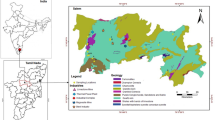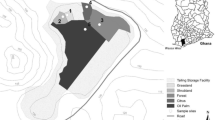Abstract
Indiscriminate anthropogenic activities have considerably changed biogeochemical balance of naturally occurring heavy metals and posed serious threat to the environment. The phosphate rock (PR) mine is typically exploited for phosphorus fertilizers in Pakistan. It is mainly composed of phosphorous and minutely of many other elements like heavy metals (HM). This was the first attempt to evaluate the impacts of phosphate rock mining on soil and crop system adjoining PR mining near Abbottabad by growing maize plants due to mountainous nature of the study area. Exchangeable and water soluble forms of the HM were determined in phosphate rock. Results showed a significant increase in the concentration of HM in soil and plant samples. The heavy metal concentrations in soil samples varied in the order of Pb > Cr > Ni > Zn > Cd. The magnitude of metal species in soil samples decreased with the increasing distance from the mine irrespective of the kind of element. Maximum concentration of each metal was found at 20 m distance while minimum at 100 m distance from the mine. Phosphate mining enhanced HM concentrations in all parts of the maize plants. Plant parts differed in HM accumulation in the order: root > shoot > grain. The fields nearer to the PR site showed higher HM concentrations in plant parts. The results revealed that maize plants showed TF > 1.0 for Cd, while TF values for other heavy metals are < 1.0. Translocation factor varied among heavy metals in maize plants in the order of Cd > Pb > Zn > Ni > Cr. Biological accumulation factor was higher for Cd, Pb, and Zn as compared with Cr and Ni. The results show that growing crops near PR mines is producing tangible impacts on soil-plant system thereby entering food chain and affecting the human and animal health.




Similar content being viewed by others
References
Ali H, Khan E, Sajad MA (2013) Phytoremediation of heavy metals-concepts and applications. Chemosphere 91(7):869–881
Ali MM, Ali ML, Islam MS, Rahman MZ (2016) Preliminary assessment of heavy metals in water and sediment of Karnaphuli River, Bangladesh. Environmental Nanotechnology, Monitoring & Management 5:27–35
Alloway BJ, Trevors JT (2013) Heavy Metals in Soils-Trace Metals and Metalloids in Soils and their Bioavailability. New York: Springer Dordrecht Heidelberg
Caussy D, Gochfeld M, Gurzau E, Neagu C, Ruedel H (2003) Lessons from case studies of metals: investigating exposure, bioavailability, and risk. Ecotoxicol Environ Saf 56(1):45–51
Chen JQ, Wang ZX, Xie W, Zhu JJ, Zhou WB (2011) Source and hazard identification of heavy metals in soils of Changsha based on TIN model and direct exposure method. Trans Nonferrous Metals Soc China 21(3):642–651
Cheng H, Hu Y (2010) Lead (Pb) isotopic fingerprinting and its applications in lead pollution studies in China: a review. Environ Pollut 158(5):1134–1146
Cirik Y, Molu Bekci Z, Buyukates Y, Ak I, Merdivan M (2012) Heavy metals uptake from aqueous solutions using marine algae (Colpomenia sinuosa): kinetics and isotherms. Chem Ecol 28(5):469–480
Cui YJ, yg Z, rh Z, Chen DY, Huang YZ, Qiu Y, Liang JZ (2004) Transfer of metals from soil to vegetables in an area near a smelter in Nanning, China. Environ Int 30(6):785–791
Cui S, Zhou Q, Chao L (2007) Potential hyperaccumulation of Pb, Zn, Cu and Cd in endurant plants distributed in an old smeltery, northeast China. Environmental Geology 51:1043–1048
El Maghraby A (2012) Phosphate mining wastes at Abu Tartur mine area, Western Desert of Egypt. Aust J Basic Appl Sci 6(10):231–248
El-Bahi S, Sroor A, Mohamed GY, El-Gendy N (2017) Radiological impact of natural radioactivity in Egyptian phosphate rocks, phosphogypsum and phosphate fertilizers. Applied Radiation and Isotopes 123:121–127
Fatoki OS (2000) Trace zinc and copper concentrations in roadside vegetation and surface soils: a measurement of local atmospheric pollution in Alice, South Africa. Int J Environ Stud 57(5):501–513
Forte J, Mutiti S (2017) Phytoremediation potential of Helianthus annuus and Hydrangea paniculata in copper and lead-contaminated soil. Water, Air, & Soil Pollution 228, 77
Freedman B, Hutchinson TC (1981) Sources of metal and elemental contamination of terrestrial environments. In: Effect of heavy metal pollution on plants, ed.^eds. Springer, Berlin, pp 35–94
Gnandi K, Tchangbedji G, Killi K, Baba G, Abbe K (2006) The impact of phosphate mine tailings on the bioaccumulation of heavy metals in marine fish and crustaceans from the coastal zone of Togo. Mine Water Environ 25(1):56–62
Goix S, Mombo S, Schreck E, Pierart A, Lévêque T, Deola F, Dumat C (2015) Field isotopic study of lead fate and compartmentalization in earthworm–soil–metal particle systems for highly polluted soil near Pb recycling factory. Chemosphere 138:10–17
Ishaque M, Ahmad I (1987) The potential of Hazara phosphates for phosphoric acid manufacture. Nutr Cycl Agroecosyst 14(3):257–263
Jung MC (2008) Heavy metal concentrations in soils and factors affecting metal uptake by plants in the vicinity of a Korean cu-W mine. Sensors 8(4):2413–2423
Kabata-Pendias A (2010) Trace elements in soils and plants. CRC press, Boca Raton
Kachenko A, Singh B (2004) Heavy metals contamination of home grown vegetables near metal smelters in NSW. In: 3rd Australian New Zealand Soils Conference, ed.^eds, pp 5–9
Ledin M, Pedersen K (1996) The environmental impact of mine wastes—roles of microorganisms and their significance in treatment of mine wastes. Earth Sci Rev 41(1–2):67–108
Lesmana SO, Febriana N, Soetaredjo FE, Sunarso J, Ismadji S (2009) Studies on potential applications of biomass for the separation of heavy metals from water and wastewater. Biochem Eng J 44(1):19–41
Lou Y, Luo H, Hu T, Li H, Fu J (2013) Toxic effects, uptake, and translocation of cd and Pb in perennial ryegrass. Ecotoxicology 22(2):207–214
Ma Y, Oliveira RS, Nai F, Rajkumar M, Luo Y, Rocha I, Freitas H (2015) The hyperaccumulator Sedum plumbizincicola harbors metal-resistant endophytic bacteria that improve its phytoextraction capacity in multi-metal contaminated soil. J Environ Manag 156:62–69
Mehmood T, Chaudhry MM, Tufail M, Irfan N (2009) Heavy metal pollution from phosphate rock used for the production of fertilizer in Pakistan. Microchem J 91(1):94–99
Organization, World Health (1976) List of maximum levels recommended for contaminants by the Joint FAO/WHO Codex Alimentarius Commission-Second series
Pantelica AI, Salagean MN, Georgescu II, Pincovschi ET (1997) INAA of some phosphates used in fertilizer industries. J Radioanal Nucl Chem 216(2):261–264
Saifullah M, Shahid M, Zia-Ur-Rehman M, Sabir HRA (2015) Phytoremediation of Pb-contaminated soils using synthetic chelates, soil rem. Plants, pp 397–414
Shahid M, Dumat C, Khalid S, Niazi NK, Antunes PMC (2016) Cadmium bioavailability, uptake, toxicity and detoxification in soil-plant system. In: Reviews of environmental contamination and toxicology, vol 241. Springer, Berlin, pp 73–137
Shahid M, Khalid M, Dumat C, Khalid S, Niazi NK, Imran M, Bibi I, Ahmad I, Hammad HM, Tabassum RA (2017) Arsenic level and risk assessment of groundwater in Vehari, Punjab Province, Pakistan. Exposure and Health:1–11
Stoica L, Georgescu I, Filip D, Bunus F (1997) Determination of valuable elements in natural phosphates. J Radioanal Nucl Chem 216(2):161–163
Teixeira JPF, Gonçalves O (2011) Mining activities: health impacts. Encyclopedia of environmental health, vol 3, pp 788–802
Tietjen C (1977) The admissible rate of waste (residue) application on land with regard to high efficiency in crop production and soil pollution abatement. In 8. Cornell Agricultural Waste Management Conference. Ithaca, NY (USA)
Wang J, Chen C (2009) Biosorbents for heavy metals removal and their future. Biotechnol Adv 27(2):195–226
Watts-Williams SJ, Turney TW, Patti AF, Cavagnaro TR (2014) Uptake of zinc and phosphorus by plants is affected by zinc fertiliser material and arbuscular mycorrhizas. Plant Soil 376(1-2):165–175
WHO (1996) Trace elements in human nutrition and health, Geneva, Swiss
Woja S, Hennig J, Plaza S, Geisler M, Siemianowski O, Skłodowska A, Ruszczyńska A, Bulska E, Antosiewicz DM (2009) ectopic expression of Arabidopsis ABC transporter MRP7 modifies cadmium root-to-shoot transport and accumulation. Environ Pollut 157(10):2781–2789
Xiong TT, Dumat C, Pierart A, Shahid M, Kang Y, Li N, Bertoni G, Laplanche C (2016) Measurement of metal bioaccessibility in vegetables to improve human exposure assessments: field study of soil–plant–atmosphere transfers in urban areas, South China. Environ Geochem Health 38(6):1283–1301
Yang X, Feng Y, He Z, Stoffella PJ (2005) Molecular mechanisms of heavy metal hyperaccumulation and phytoremediation. J Trace Elem Med Biol 18(4):339–353
Acknowledgements
We sincerely acknowledge Dr. M.H.Qazi for his valuable discussions related to the field work conducted in this study.
Author information
Authors and Affiliations
Corresponding authors
Additional information
Editorial handling: Haroun Chenchouni
Rights and permissions
About this article
Cite this article
Afshan, Ahmad, S., Imran, M. et al. Role of phosphorous mining in mobilization and bioaccessibility of heavy metals in soil-plant system: Abbottabad, Pakistan. Arab J Geosci 12, 319 (2019). https://doi.org/10.1007/s12517-019-4479-9
Received:
Accepted:
Published:
DOI: https://doi.org/10.1007/s12517-019-4479-9




